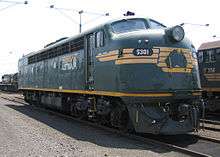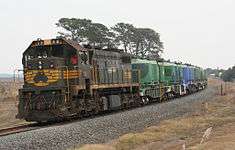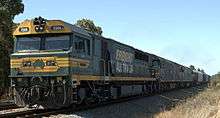Freight Australia
Freight Australia was an Australian railway company that purchased the V/Line Freight business from the Government of Victoria in 1999. Initially known as Freight Victoria, it operated rail freight services and controlled non-urban rail track in the state of Victoria, later expanding into freight haulage in other states. Freight Australia was sold to Pacific National in August 2004.
 S class at North Geelong in January 2006 | |
| Industry | Railway operator |
|---|---|
| Successor | Pacific National |
| Founded | 1 May 1999 |
| Defunct | 16 August 2004 |
| Headquarters | |
Area served | New South Wales Victoria |
| Parent | A Goninan & Co Fluor Daniel Macquarie Bank RailAmerica |

Background
V/Line formerly had a freight division, known as V/Line Freight. Under the Kennett State Government, V/Line was split into two separate entities on 1 July 1997: V/Line Passenger and V/Line Freight, with separate management to each other in preparation for privatisation.[1] When V/Line was privatised in 1999, the passenger and freight divisions were sold separately.
History
Inception
The company was formed in March 1999 when the Freight Victoria consortium was announced by the Victorian State Government as the successful bidder for the state owned V/Line Freight business.[2][3][4] The consortium consisted of RailAmerica, Fluor Daniel, Macquarie Bank and A Goninan & Co.[4][5]
The sale included 107 locomotives and more than 2,800 freight wagons,[5] maintenance centres at South Dynon, Geelong, Portland and Wodonga,[6] as well as a 45-year lease (in renewable 15-year leases) on 4,756 km of broad gauge intrastate track in regional Victoria.[2] A green and yellow livery was adopted for rolling stock. The company commenced operations on 1 May 1999.[1]
Expansion
Regular broad gauge trains in Victoria carried logs sourced from Gippsland, paper products from Maryvale, gravel from Kilmore East, as well as general freight to and from Wodonga, Tocumwal, Shepparton, Swan Hill, Bendigo, Boort, Echuca, Deniliquin, Mildura, Warrnambool and Geelong. Grain trains also operated throughout the state as required. Freight Victoria also operated standard gauge trains in Victoria to Wodonga and Dimboola.[1]
Freight Victoria soon begun gaining contracts outside Victoria, taking advantage of open access regimes. In October 1999 it began hauling logs from Queanbeyan to Port Kembla and in December 1999 from Wallerawang.[7][8]
In March 2000 the company was renamed Freight Australia.[9] In April 2000 Freight Australia began hauling export grain from southern New South Wales to Melbourne and Port Kembla.[10][11] In October 2000 it commenced hauling SCT Logistics services from Melbourne to Perth.[1][12]
Further interstate contracts followed:
- Fuel: from Sandown to West Tamworth, Dubbo, and Canberra
- Domestic grain: from throughout NSW to Weston Milling, Enfield from 2002[13]
- Export grain: from the NSW Riverina district to Port Kembla, or Appleton Dock, Melbourne.
- Friskies: grain transported to a pet food processing plant in Blayney, from the central-west of NSW.
- Logs: spasmodic traffic from Canberra to Port Kembla
- Cement: Berrima to Melbourne[1]
Demise
In October 2003 Freight Australia was put up for sale.[3] The Australian Competition and Consumer Commission (ACCC) looked at the sale, fearing that Pacific National would create a rail and freight monopoly if it won control of the operator. At the time other potential buyers included Australian Railroad Group, Queensland Rail, and merchant bank Babcock & Brown.[14]
In March 2004 RailAmerica announced the sale of Freight Australia to Pacific National subject to government and regulatory approval.[1] In July 2004 the ACCC announced it would not oppose the acquisition,[15] and in August 2004 the Victorian Government approved the transfer of the Freight Australia infrastructure lease to Pacific National.[16]
Fleet
Included in the purchase of V/Line Freight were 107 diesel locomotives and more than 2,800 freight wagons,[5] which had been owned and operated by the Victorian Railways and their successors. The newest and most powerful locomotives were the 3,300 hp G class delivered from 1984, but other locomotives dated as far back as the 1950s.
With traffic growing Freight Victoria decided to replace the prime movers in number of the G class, increasing the power output to 3,800 hp. The older X class diesels also saw a more extensive power upgrade program, being stripped to the frame and rebuilt as the XR class. The company only purchased a single new locomotive, V544 which was built new in 2002 to replace two written off G class locomotives. Additional rollingstock was also acquired, including new 100 tonne capacity grain hoppers built by Alstom at the Ballarat North Workshops,[17] second hand grain hoppers from FreightCorp,[18] and the conversion of surplus vans into log and container flats.[19]
To fulfill a contractual condition with customer CRT Group that if Freight Australia was acquired by a competitor of CRT Group, 10,000 hp (7,500 kW) of locomotive power (calculated by the business CRT Group was offering Freight Australia) was to be transferred to them, two G and two X class locomotives were transferred to CRT Group.[20] The balance of the fleet was included in the sale to Pacific National.
References
- Peter Attenborough (June 2004). "Freight Australia". Australian Model Railway Magazine. 21 (9): 24–27.
- RailAmerica Backed Freight Victoria Consortium Wins Australian V/Line Freight Bid Archived 13 August 2009 at the Wayback Machine Business Wire 22 February 1999
- Rail giants to battle for Freight Australia Archived 23 November 2015 at the Wayback Machine The Age 1 November 2003
- "Freight Victoria Bid Wins V/Line Freight" Railway Digest March 1999 page 9
- Railway Age: 'Railamerica Wins In Australia - Freight Victoria consortium led by RailAmerica Inc. acquires V/Line Freight' - March 1999
- The Guardian: "RailAmerica buys V/Line Freight" - 7 April 1999 Archived 11 September 2007 at the Wayback Machine
- "Freight Victoria's NSW Log Traffic" Railway Digest December 1999 page 15
- "Wang Logs Commence" Railway Digest January 2000 page 38
- "New Colours" Railway Digest April 2000 page 39
- "Freight Australia - Grain haulage intensifies" Railway Digest June 2000 page 33
- "Freight Australia reaches Cowra" Railway Digest August 2000 page 34
- "Freight Australia Takes Over SCT Services to Perth" Railway Digest November 2000 page 11
- Freight Australia wins NSW grain job Archived 3 October 2009 at the Wayback Machine Railexpress.com.au 22 October 2002
- Alarm on bid for Victorian Rail Freight Archived 25 July 2008 at the Wayback Machine The Age 8 December 2003
- ACCC not to oppose Freight Australia acquisition Archived 29 March 2012 at the Wayback Machine Australian Competition & Consumer Commission 2 July 2004
- Regional Rail Set to Grow With Freight Australia Transfer Agreed 16 August 2004 Archived 6 July 2011 at the Wayback Machine Office of the Treasurer, Minister for Public Transport 16 August 2004
- "First grain wagons roll - Alstom Australia delivers railroad cars to Freight Australia". Asia Pacific Rail. findarticles.com. September 2001. Archived from the original on 29 June 2006. Retrieved 23 October 2008.
- Peter J Vincent. "VHBF - Grain Hopper wagon". pjv101.net. Retrieved 23 October 2008.
- Peter J Vincent. "VFTX - Log Traffic Flat Wagon". pjv101.net. Retrieved 23 October 2008.
- Peter Attenborough (February 2006). "Colin Rees Transport". Australian Model Railway Magazine. 22 (256): 37.

